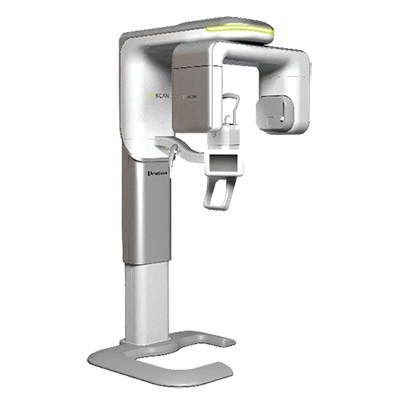The Right Technology to Diagnose and Treat TMJ Disorder
The TMJ Joint is a highly complex mechanism which is responsible for thousands of motions every day. There are a number of factors that can contribute to TMJ Disorder, and that’s why Dr. Jim Beck relies on advanced technology to diagnose and treat it. CBCT 3D Cone Beam Tomography–This is a fast and convenient way to get a comprehensive three-dimensional view of all the hard and soft tissue related to the Temporomandibular Joint, including your teeth, bones, and nerve pathways.

Treating TMJ Disorder
If you suffer from chronic headaches, facial pain, neck pain, earaches/ear ringing, or pain when chewing, you could have a TMJ disorder or TMD Temporomandibular Disorder. Additional symptoms include clicking noises when you open/close your mouth, clenching/grinding your teeth during the day or while you sleep, and limited ability to open your mouth. All of these things can be associated with TMD, so if you are experiencing any of these symptoms, give us a call and Dr. Beck can properly diagnose and treat you.
Additional symptoms of TMD include clicking noises when you open and close your mouth or when chewing. Grinding your teeth, either during the day or while you sleep, is also frequently associated with TMD.
Dr. Jim Beck in Pueblo is a dentist who specializes in the treatment of TMJ Disorder. If you think you might be suffering from TMD, call our office right away at 719-544-0901 to schedule an appointment with Dr. Beck. He’ll make sure you get the right diagnosis and the treatment you deserve.
The Temporomandibular Joint and TMD
TMD refers to a number of different conditions that affect one or both temporomandibular joints (TMJ). Your two temporomandibular joints are located beneath your ears. The TMJ is a remarkably complex joint which is called upon to perform a wide range of motions when you’re speaking, yawning, and eating. That’s why it’s subject to a great deal of stress.
You have two temporomandibular joints, one located slightly in front of both of your ears. It is common for people to have ear problems, such as pain or ringing in the ears, that are caused by a dysfunctional joint; along with the other symptoms mentioned.
Causes and Symptoms of TMD
There are several factors that can contribute to TMD, including stress, arthritis, clenching, dysfunctional joints, and genetics. Habits such as excessively chewing ice or gum, holding a phone between your neck and ear, and poor posture can also play a role in developing TMD. Another major factor that can lead to TMD is an improper bite known as an occlusion. There are numerous symptoms that could be a sign that you have TMD, including:
- Pain and swelling in the TMJ region
- Headaches
- Clicking noises when you talk, chew, or yawn
- Earaches
- Teeth clenching and grinding
- Toothaches
- Pain while eating
- Pain in one or both shoulders
- Dizziness
- Ringing in the ears (tinnitus)
- Neck Pain
- Teeth don’t fit together when you bite down

Diagnosis and Treatment of TMD
During your appointment, Dr. Jim Beck will perform a complete examination of the head, neck, and oral region. Further diagnostics such as x-rays and i-CAT Cone Beam imaging will also be provided. Dr. Beck will then design a course of treatment to meet your individual needs.
Your treatment could include physical therapy, lifestyle changes, nutrition counseling, and stress management techniques. Oral appliances such as splints or mouthguards are often effective for treating TMD that’s related to nighttime teeth clenching or grinding. These are custom-designed orthotics provided under the supervision of a trained practitioner.
Dr. Beck features a number of advanced treatments for TMD.
- Trigger point injection–Small quantities of anesthetic and anti-inflammatory medication is injected directly into inflamed muscle groups.
- Iontophoresis (injection without a needle)–An electric current is used to deliver small doses of medication.
- Tens Therapy (Transcutaneous Electrical Nerve Stimulation)–Tiny doses of electricity are used to stimulate contractions which allow your muscles to heal themselves.
- MLS Cold Laser Therapy–Reduces swelling of the TMJ.
